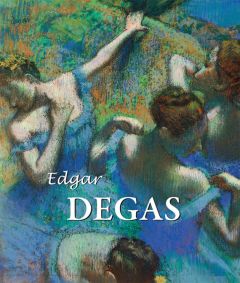Текст книги "Edgar Degas"

Автор книги: Nathalia Brodskaya
Жанр: Изобразительное искусство и фотография, Искусство
сообщить о неприемлемом содержимом
Текущая страница: 1 (всего у книги 8 страниц) [доступный отрывок для чтения: 2 страниц]
Natalia Brodskaïa
Edgar Degas
© Confidential Concepts, worldwide, USA
© Parkstone Press International, New York, USA
* * *


Self-Portrait Saluting, 1865.
Oil on canvas, 92.5 × 66.5 cm.
Museu Calouste Gulbenkian, Lisbon.
Edgar Degas and his works

Young Spartans Exercising, c. 1860.
Oil on canvas, 109.5 × 155 cm.
The National Gallery, London.
Edgar Degas was closest to Pierre-Auguste Renoir in the Impressionist’s circle, for both favoured the animated Parisian life of their day as a motif in their paintings. Degas did not attend Charles Gleyre’s studio; most likely he first met the future Impressionists at the Café Guerbois. It is not known exactly where he met Édouard Manet. Perhaps they were introduced to one another by a mutual friend, the engraver Félix Bracquemond, or perhaps Manet, struck by Degas’ audacity, first spoke to him at the Louvre in 1862. Two months after meeting the Impressionists, Degas exhibited his canvases with Claude Monet’s group, and became one of the most loyal of the Impressionists: not only did he contribute works to each of their exhibitions except the seventh, he also participated very actively in organising them. All of which is curious, because he was rather distinct from the other Impressionists.
Degas came from a completely different milieu than that of Monet, Renoir, and Alfred Sisley. His grandfather René-Hilaire de Gas, a grain merchant, had been forced to flee from France to Italy in 1793 during the French Revolution. Business prospered for him there. After establishing a bank in Naples, de Gas wed a young girl from a rich Genoan family. Edgar preferred to write his name simply as Degas, although he happily maintained relations with his numerous de Gas relatives in Italy.
Enviably stable by nature, Degas spent his entire life in the neighbourhood where he was born. He scorned and disliked the Left Bank, perhaps because that was where his mother had died. In 1850, Edgar Degas completed his studies at Lycée Louis-le-Grand, and, in 1852, received his degree in law. Because his family was rich, his life as a painter unfolded far more smoothly than for the other Impressionists.
Degas started his apprenticeship in 1853 at the studio of Louis-Ernest Barrias and, beginning in 1854, studied under Louis Lamothe, who revered Jean-Auguste-Dominique Ingres above all others and transmitted his adoration for this master to Edgar Degas. Degas’ father was not opposed to his son’s choice. On the contrary: when, after the death of his wife, he moved to Rue Mondovi, he set up a studio for Edgar on the fourth floor, from which the Place de la Concorde could be seen over the rooftops. Edgar’s father himself was an amateur painter and connoisseur; he introduced his son to his many friends. Among them were Achille Deveria, curator of the Department of Prints and Drawings at the Bibliothèque Nationale, who permitted Edgar to copy from the drawings of the Old Masters: Rembrandt, Dürer, Goya, Holbein. His father also introduced him to his friends in the Valpinçon family of art collectors, at whose home the future painter met the great Ingres. All his life Degas would remember Ingres’ advice as one would remember a prayer: “Draw lines… Lots of lines, whether from memory or from life” (Paul Valéry, Écrits sur l’Art [Writings on Art], Paris, 1962, p. 187).
Starting in 1854, Degas travelled frequently to Italy: first to Naples, where he made the acquaintance of his numerous cousins, and then to Rome and Florence where he copied tirelessly from the Old Masters. His drawings and sketches already revealed very clear preferences: Raphael, Leonardo da Vinci, Michelangelo, and Andrea Mantegna, but also Benozzo Gozzoli, Ghirlandaio, Titian, Fra Angelico, Uccello, and Botticelli. He went to Orvieto Cathedral specifically to copy from the frescoes of Luca Signorelli, and visited Perugia and Assisi. The pyrotechnics of Italian painting dazzled him. Degas was lucky like no other. One can only marvel at the sensitivity Edgar’s father demonstrated with respect to his son’s vocation, at his insight into his son’s goals, and at the way he was able to encourage the young painter. “You’ve taken a giant step forwards in your art, your drawing is strong, your colour tone is precise,” he wrote his son. “You no longer have anything to worry about, my dear Edgar, you are progressing beautifully. Calm your mind and, with tranquil and sustained effort, stick to the furrow that lies before you without straying. It’s your own – it is no one else’s. Go on working calmly, and keep to this path” (J. Bouret, Degas, Paris, 1987, p. 23).

Scene of War in the Middle Ages (detail), 1865.
Oil on paper, on canvas, 83.5 × 148.5 cm.
Musée d’Orsay, Paris.
In 1855, Degas began to pursue studies at the École des beaux-arts, but did not show any particular zeal for his work. Degas preferred to learn at the museums. As soon as his first vacation arrived, Degas took the opportunity to return to Italy. There, at the Villa Medici, fate brought him into contact with residents of the École des beaux-arts who would become his friends: the painters Léon Bonnat, Henri Fantin-Latour, Élie Delaunay, Gustave Moreau, the sculptors Paul Dubois and Henri Chapu, and the musician Georges Bizet, who had not yet composed Carmen. Their gatherings in the old neighbourhoods of Rome, and the picnics with the beauties of the Italian landscape in the background, would remain impressed on his memory to the end of his life.
In the 1850s, Degas started doing portraits and self-portraits. From the very beginning in Degas’ portraits, one senses an attentive observer of human psychology. In Italy he began to paint portraits of his family members. One of his very first is an admirable portrait of his grandfather, René-Hilaire de Gas, it is reminicent of Titian’s portraits to mind. Its professional quality and Degas’ ease in handling the idiom of classical painting makes it possible to compare it to portraits by Ingres. This canvas foretells a future for the painter as a great portraitist. And he indeed became a remarkable portraitist. During the 1850s Degas began to paint the portraits of members of the Bellelli family, that of his father’s sister, who had married Baron Bellelli. He did composition studies, sketched the baron and his wife, painted his own cousins Giulia and Giovannini, and studied the hands of his subjects. The result was a large painting – 200 by 253 centemetres, and painted in Paris, The Bellelli Family, that recalls the portraits of Hans Holbein, Jean Clouet, or Diego Velázquez. But the sky-blue wallpaper with small white flowers lightens the colour scheme, and gives the painting the cozy, intimate feel of a life of ease. The classical balance of the composition is broken, completely unexpectedly by a single detail: the master of the house, seated with his back to the viewer, turns so spontaneously and with such liveliness towards his wife that, in an instant, the impression of models in the act of posing vanishes. With his solid training in classical principles, the painter is beginning to turn, little by little, towards the modern life which will soon absorb him completely.

Mlle Fiocre in the Ballet “La Source” (detail), 1866–1868.
Oil on canvas, 110.5 × 91.4 cm.
Albright-Knox Art Gallery, Buffalo.

Woman Ironing, c. 1869.
Oil on canvas, 92.5 × 73.5 cm.
Neue Pinakothek, Munich.
The enormous painting The Daughter of Jephthah is full of the influences of different masters, from Nicolas Poussin to Raphael, and Eugène Delacroix. The painting Scene of War from the Middle Ages or The Misfortunes of the City of Orléans, with its baffling subject, could have been drawn from a tale that Degas’ grandfather, who was originally from Orléans, had told him. It reminds one of Delacroix. As early as the 1850s he discovered two absolutely new and unexpected subjects: horses and the ballet. In 1859, the Valpinçon family invited Edgar to spend a few weeks at their estate in Ménil-Hubert-sur-Orne where they had a horse-breeding farm. His eye noted their proportions, the particularities of the horse’s skeleton, and the play of its muscles. After his first rather complex compositions depicting racetracks, Degas learned the art of translating the nobility and elegance of horses, their nervous movements, and the formal beauty of their musculature The Parade (Racehorses in front of the Tribunes).
Around the middle of the 1860s Degas made yet another discovery. In 1866, he painted his first composition with ballet as a subject: Mademoiselle Fiocre in the Ballet “La Source“. Degas frequently attended the Paris Opera, where, in 1866, Eugénie Fiocre often danced The Spring. It’s true that, in this first painting, the ballet itself was not yet depicted. It was more a portrait of the ballet dancer. Mlle Fiocre is seated on stage surrounded by Oriental scenery with a horse at her side. Degas had always been a devotee of the theatre, but from this time on, it would become more and more the focus of his art. It gradually permeated his painting through his portraiture. After Mlle Fiocre, he turned to painting portraits of musicians.
In 1869 he did an admirable portrait of his father with Lorenzo Pagans, the musician: Degas’ Father Listening to Lorenzo Pagans Playing the Guitar. Pagans occupies the foreground, wholly absorbed in his music, a guitar in his hands. In spite of the almost classical construction of the composition and the seemingly static nature of the subjects, there is action in this painting: Pagans is gently strumming and Degas’ father is listening. This becomes a characteristic aspect of Degas’ art. Like Manet and the Impressionists, he rejects subject and literary narrative, but in his own paintings there is always something happening. Also in 1869, Degas painted The Orchestra at the Opera.
At first glance this painting is also just a portrait of musicians. In fact it is a portrait of a whole group of the painter’s friends, whom his imagination has gathered together in the orchestra pit. The faces are painted in close up, they are individualised, they have character, and, above all, they are not posing, but, instead, are engrossed in the music. Before Edgar Degas, nothing like this had ever been done before. Three years later, in 1872, Degas’ first painting devoted solely to the ballet appeared: Le Foyer de la danse à l’Opéra de la rue Le Peletier (The Dance Foyer at the Opera on the rue Le Peletier). Degas moved from the theatre on to the rehearsal halls, where the dancers practised and took their lessons. This was how Degas arrived at the second sphere of that immediate, everyday life that was of interest to him. The ballet would remain his passion until the end of his days.
When the Franco-Prussian war began in 1870, Degas enlisted in the French National Guard artillery. It was during his service in the army that he learned he might lose his eyesight, which would have a tragic impact on his life.
In 1872, Degas went to New Orleans to visit his mother’s relatives who were cotton traders. Although the purpose of the trip was business, he sketched a great deal. Though by nature disinclined to react with much emotion, he was happy with his new impressions all the same. For the 1874 Impressionist exhibition, Degas contributed canvases and drawings with motifs that, from then on, would forever be associated with him: the theatre, ballet classes, washerwomen, racetracks, and nudes. In the exhibition that followed, portraits, milliners, and paintings executed from impressions of New Orleans appeared. Cabarets and the circus would come later. At the beginning of his development as an Impressionist, two paintings represented extremely important steps.
Degas was the only painter of his generation who took photography seriously. He took intrest in it rather late, in the middle of the 1880s, and bought a camera around 1895. This proves that the unique features of Degas’ compositions do not relate to the direct influence of the camera, but to the specificity of his own vision of the world. When he began to take photographs himself, it was his vision that influenced the compositions of his photographs, not the other way around.
In 1876, Degas painted The Absinthe Drinker (Glass of Absinthe). At that time the artists had already abandoned the Café Guerbois and reunited at La Nouvelle Athènes in the Place Pigalle. Degas had lived in this neighbourhood for a large portion of his life: in rue Blanche, rue Fontaine, and rue Saint-Georges. He could now regularly be found in the evenings on the terrace of La Nouvelle Athènes with Édouard Manet, Émile Zola, and various Impressionists and critics. For his new painting he asked his friend, engraver Marcellin Desboutin, just back from Florence, and the pretty actress Ellen Andrée to pose for him. Ellen Andrée would later pose at the same location, on the terrace of La Nouvelle Athènes, for Manet’s The Plum, and also for Renoir’s Luncheon of the Boating Party on the island of Croissy. Degas depicted her as a prostitute of the Parisian streets with a lost look, sitting absolutely still before a glass of absinthe, absorbed in thought. At her side, a pipe clenched between his teeth and a hat pushed to the back of his head, one of the café regulars is seated. He also seems to be looking into the distance, not aware of the woman seated just beside him. Squeezed into a corner behind little empty tables, they are almost touching one other, but each is in their own world. Again, Degas has succeeded in setting down on the canvas something almost impossible to capture: the bitter solitude of a human being in one of the merriest, liveliest cities in the world.
One of the main differences between Degas’ ideas and those of the other Impressionists was his point of view regarding open-air painting. For all the others, open-air painting was both an aim and an essential condition of their work. However, with Degas, it was not living nature that caused a landscape to appear on paper or canvas. On the contrary, it was a shape or a line seen at random that would give birth to a landscape in his imagination. Degas’ odd attitude towards landscapes had two explanations, however. Firstly, Degas’ greatest misfortune must not be forgotten, the weakness of his eyesight. What was most important, though, was that Degas had more confidence in his prodigious memory than in a fleeting impression.

The Orchestra at the Opera (detail), c. 1870.
Oil on canvas, 56.5 × 46 cm.
Musée d’Orsay, Paris.

Interior (The Rape) (detail), c. 1868–1869.
Oil on canvas, 81.3 × 116.3 cm.
The Philadelphia Museum of Fine Arts, Philadelphia.

The Ballet from “Robert le Diable”, 1871.
Oil on canvas, 66 × 54.3 cm.
The Metropolitan Museum of Art, New York.
The second difference between Degas and the Impressionists was in his attitude towards drawing. Renoir and his friends had been accused of not knowing how to draw because, in their work, the vibrations of air and light had the effect of blurring their line; their colour predominated over their drawing. For Degas drawing always came first.
After the death of Degas’ father in 1873, the Degas family bank failed and there was nothing left for the painter but to rely on his art. Like the other Impressionists, he suffered from the fact that his paintings were impossible to sell and, like Renoir, Monet, Sisley, and Camille Pissarro, he went to Durand-Ruel to ask for money. And, like Sisley, he never painted commissions, he worked only on what interested him. He kept repeating, reworking, and varying his same favourite motifs, he liked improving himself. His friends recounted how he could start over and over again on one and the same work without ever fully completing it.
At the close of the 1870s, Degas added cabaret scenes to his repertoire – before Manet painted his Bar at the Folies-Bergère. What is represented in The Absinthe Drinker is, in fact, the work of a stage or film director. In 1877, Degas painted two paintings, Women on a Café Terrace, sometimes called Café, Boulevard Montmartre and Café-Concert at ‘The Ambassadors’. In these, the painter seems to be representing a moment glimpsed at random. Objectively and instantaneously the painter sets down on canvas the posturing, gestures, and expressions of the ladies as they chatter among themselves. “M. Degas seems to have hurled a challenge at the Phillistines, that is to say the classicists,” wrote the critic Alexandre Pothey in an article on the third exhibition of the Impressionists. “The women in Women on a Café Terrace are frighteningly realistic. These painted, withered creatures, reeking of vice, cynically recounting the events and gestures of the day – you’ve seen them, you know them, and you’ll come across them again on the boulevards soon” (L. Venturi, op. cit., vol. 2, p. 303).
It seems strange that as refined an artist as Degas, a frequenter of society salons, would have been aware in Paris of those washerwomen and pressers who became the objects of his study. Yet, when he was in New Orleans and felt nostalgic for France, it was the washerwomen who embodied and symbolised the French life of his time for him, to which he dreamt of returning as quickly as possible. He drew women leaning over their irons and found an original grace and beauty in their repetitive movements. His firm line set down the mechanics of their movements, while the colour, by means of a few light patches, gave the appearance of a black and white photograph as it is being developed (Two Laundresses).
He painted ballet classes during lessons and as the dancers rested. It was rare for a ballet dancer to appear on his canvases as an airy, ethereal vision. Drawing, in these instances, makes way for colour to play the principal role. In the unreal atmosphere of the stage, the pink, sky-blue, and white tutus glitter and disappear. Most often, the ballet dancer in a Degas work is shown simply as a woman exhausted from pushing herself too hard. She has lost her stage charm. She exercises endlessly at the bar, and she strains as she stretches her tired legs. She is weak and miserable. The truth of everyday life would enter in at the moments when the ballet dancer was protected from the gaze of strangers, or when, bent over with fatigue, she would have to go through the humiliation of a long wait to be seen by the theatrical director (Waiting, New York, Havemeyer Collection).
At the sixth Impressionist exhibition everyone marvelled at the wax statuette of a ballet dancer, almost one metre high, The Little Ballet Dancer. The tutu was of real white tulle, the bodice of waxed yellow canvas, the hair was knotted in a ponytail with a red satin ribbon, and the ballet slippers had yellow laces. Upright, in ballet position, her hands are behind her back, her head thrown back. “With her tarlatan petticoat, skinny, and as ugly as can be,” wrote the critic Charles Ephrussi, “but standing erect, arching back, and swaying, with that angular movement common to dance apprentices. She is rendered firmly, boldly, and with shrewdness, in a way that conveys, with infinite wisdom, the private demeanor and manner as well as the profession, embodied in the person… An ordinary artist would have turned this dancer into a puppet. M. Degas has turned her into a distinct, incisive, technically precise work, and in a truly original form” (Degas Inédit [Degas Unpublished], op. cit., p. 336–337).
The nude was no less important as an object of study for Degas: he drew it tirelessly all his life. “The same subject has to be done ten, a hundred times. Nothing in art should look like an accident, even movement” (J. Bouret, op. cit., p. 58). Movement, still more movement, always movement… Professional models would pose for Degas; his demands seemed absurd to them. Instead of sitting the young woman down or placing her, standing, in a well defined pose, he asked her to dry herself and do up her hair. Was the painter even drawing her? No: he stood standing against the wall, arms folded across his chest, watching her. Occasionally he climbed on a stool and watched her from above. Only after the model left would he begin to draw. Degas gained access to a world that, until then, had never let people from the outside come near: he represented women in their private surroundings, which belonged to them alone. He drew them in poses in which it is impossible to pose. She washes, squatting, in the bathtub. She combs her long hair, which a moment later she will toss back. Twisting around clumsily, she dries her back. Each drawing and each pastel seems to represent one image from an endless film of women washing and grooming themselves.
As he grew older, Degas made more and more sculpture. “With my eyesight going,” he said to the dealer Vollard, “I now have to take up blind men’s work” (J. Bouret, op. cit., p. 209). He modelled, in wax, what he knew best: ballet dancers, horses, and nudes. Ambroise Vollard was crestfallen to see how Degas would destroy his wax masterpieces so he could have the pleasure, as he put it, of starting them again. In his last years, Degas was almost completely blind. He died 27 September 1917. Among the group of several friends who came to accompany him to Montmartre cemetery there was only one Impressionist: Claude Monet. The other friend who had survived him, Renoir, was confined to an invalid’s armchair. In the midst of the First World War, the painter’s death went almost unnoticed.

The Dance Foyer at the Opera on the rue Le Petelier, 1872.
Oil on canvas, 32.7 × 46.3 cm.
Musée d’Orsay, Paris.

The Dancing Class (detail), c. 1870.
Oil on wood, 19.7 × 27 cm.
The Metropolitan Museum of Art, New York.

Orchestra Musicians, 1872.
Oil on canvas, 69 × 49 cm.
Städel-Museum, Frankfurt.
Around the time the notorious 1863 Salon des Refusés signalled the clear distinction in French painting between a revolutionary avant-garde and the conservative establishment, Edgar Degas painted a self-portrait which could hardly have looked less like that of a potential revolutionary. He appears a perfect middle-class gentleman or, as the Cubist painter André Lhote put it, like ‘a disastrously incorruptible accountant’. Wearing the funereal uniform of the 19th-century male bourgeois which, in the words of Baudelaire, made them look like ‘an immense cortège of undertakers’ mutes’, Degas politely doffs his top hat and guardedly returns the scrutiny of the viewer. A photograph taken a few years earlier, preserved in the French National Library, shows him looking very much the same, although his posture is more tense and awkward than in the painting.
The Degas in the photo holds his top hat over his genital area in a gesture unconsciously reminiscent of that of the male peasant in Jean-François Millet’s Angelus. Salvador Dalí’s provocative explanation of the peasant’s uncomfortable stance was that he was attempting to hide a burgeoning erection. Degas’ sheepish and self-conscious expression also suggests an element of sexual modesty. For an artist who once said that he wanted to be both ‘illustrious and unknown’, any speculation about his sexuality would have seemed to him an unpardonable and irrelevant impertinence.
Nevertheless, the peculiar nature of much of Degas’ subject matter, the stance of unrelenting misogyny he adopted, and the very lack of concrete clues about his personal relationships have fuelled such speculation from the beginning. As early as 1869 Manet confided to the Impressionist painter Berthe Morisot, with whom Degas was conducting a bizarre and somewhat unconvincing flirtation, ‘He isn’t capable of loving a woman, much less of telling her that he does or of doing anything about it.’ In the same year, Morisot wryly described in a letter to her sister how Degas ‘came and sat beside me, pretending to court me – but this courting was confined to a long commentary on Solomon’s proverb, ‘Woman is the desolation of the righteous’…’.
Rumours of a sexual or emotional involvement with another gifted female painter, the American Mary Cassatt, can also be fairly discounted with confidence, although the fact that Cassatt burnt Degas’ letters to her might suggest that there was something that she wished to hide. Degas’ failure to form a serious relationship with any member of the opposite sex has been attributed to a variety of causes, such as the death of his mother when he was at the sensitive age of thirteen, an early rejection in love, and impotence resulting from a venereal infection. This last theory is based on a jocular conversation between Degas and a model towards the end of his life and need not be taken too seriously.
In 1858, Degas formed an intense and sentimental friendship with the painter Gustave Moreau. The emotional tone of Degas’ letters to the older artist might suggest to modern eyes an element of homosexuality in their relationship. ‘I am really sending this to you to help me wait for your return more patiently, whilst hoping for a letter from you… I do hope you will not put off your return. You promised that you would spend no more than two months in Venice and Milan.’
But whereas Moreau’s paintings exude an air of latent or even overt homosexuality, the same cannot be said of Degas’. There are accounts of Degas chatting in mellow and contented moods with models and dancers towards the end of his life, but it seems likely that, in common with many 19th-century middle-class men, he was afraid of and found it hard to relate to women of his own class. His more outrageously misogynistic pronouncements convey a strong sense of his fear.
‘What frightens me more than anything else in the world is taking tea in a fashionable tea-room. You might well imagine you were in a hen-house. Why must women take all that trouble to look so ugly and be so vulgar?’ or ‘Oh! Women can never forgive me. They hate me. They can feel that I leave them defenceless. I show them without their coquetry, as no more than brute animals cleaning themselves!… They see me as their enemy – fortunately, for if they did like me, that would be the end of me!’
Degas’ portraits of middle-class women have faces, unlike his dancers, prostitutes, laundresses, milliners, and bathers who are usually stereotyped or quite literally faceless. On the other hand, these middle-class women may seem intelligent, rational, and sensitive, but are nevertheless a grim lot, without warmth or sensuality. Many of Degas’ female relatives seem to be overwhelmed by frigid and loveless melancholy. His nieces Giovanna and Giulia Bellelli turn from one another without the slightest trace of sisterly intimacy or affection. Grimmest of all is the portrait of his aunt, the Duchess of Montejasi Cicerale, and her two daughters in which the implacable old woman seems to be separated from her offspring by an unbridgeable physical and psychological gulf.
The theme of tension and hostility between the sexes underlies many of Degas’ most ambitious works of the 1860s, both in genre-like depictions of modern life such as Pouting and Interior (formerly known as The Rape and probably inspired by Émile Zola’s novel Thérèse Raquin) and in elaborate historical scenes such as Young Spartans Exercising and Scene of War in the Middle Ages. This last – the most lurid and sensational picture Degas ever painted – shows horsemen shooting arrows at a group of nude women. The women’s bodies show no wounds or blood, but fall in poses suggestive more of erotic frenzy than of the agony of death. From the time that Degas reached maturity as an artist in the 1870s, most of his depictions of women – apart from a few middle-class portraits – include more than a suggestion that the women are prostitutes. Prostitution in 19th-century Paris took a wide variety of forms, from the bedraggled street-walker desperate for a meal to the ‘Grande Horizontale’ able to charge a fortune for her favours. Virtually any woman who had to go out to work and earn a living was regarded as also liable to sell her body. So it was that Degas’ depictions of singers, dancers, circus performers, and even milliners and laundresses could have disreputable connotations for his contemporaries that might not always be apparent today.

A Woman Ironing, 1873.
Oil on canvas, 54.3 × 39.4 cm.
The Metropolitan Museum of Art, New York.

The Dance Class, c. 1873–1876.
Oil on canvas, 85.5 × 75 cm.
Musée d’Orsay, Paris.
It was during the Second Empire (from 1852 to 1871) that Paris consolidated its reputation as the pleasure capital of Europe. That ‘love for sale’ was one of the chief attractions of Paris for foreign visitors is made abundantly clear by the operetta La Vie Parisienne composed by Jacques Offenbach for the 1867 Paris World Exhibition. The libretto, written by Degas’ close friend Ludovic Halévy and his collaborator Henri Meilhac, shamelessly celebrates Paris’ reputation as ‘the modern Babylon’ and a great focus for venal love.
Amongst the characters are a ‘Grande Horizontale’ with the outrageously punning name of Métella (roughly translatable as ‘put it in’), a pretty glove-maker called Gabrielle who might have stepped from one of Degas’ pastels of milliners, a Brazilian millionaire who wants to lose his fortune to Parisian ‘hussies’, a Swedish Baroness who longs to hear the singer Thérésa and her husband who wants to experience and enjoy everything at once jusque-là (to the fullest).
Prostitution was a major theme of French writers and artists throughout the second half of the 19th century. Literary interest in prostitution peaked around 1880. Edmond de Goncourt published La Fille Elisa in 1877, and Émile Zola, Nana in 1879–1880. Guy de Maupassant made his reputation with Boule de Suif in 1880 and followed it up the next year with the endearing La Maison Tellier. Degas’ references to the Parisian traffic in female flesh were often scrupulously discreet – a glimpse of a gentleman’s black trousers amongst the scenery of the opera, or of the gaudy plumage of a courtesan’s hat at the race-course as her carriage passes from view. Sometimes it is no more than a pervasively suggestive atmosphere that would nonetheless have been quite perceptible to men of Degas’ class and tastes.
Правообладателям!
Данное произведение размещено по согласованию с ООО "ЛитРес" (20% исходного текста). Если размещение книги нарушает чьи-либо права, то сообщите об этом.Читателям!
Оплатили, но не знаете что делать дальше?








































